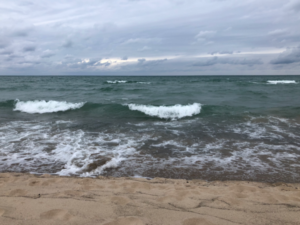26 Sep What Brought Me Here: Julia Whyte
I’ve always loved animals and being in nature, and I found my love for animal behavior and primatology at Franklin & Marshall College. I pictured myself following in the footsteps of Jane Goodall, Dian Fossey, and Biruté Galdikas, dedicating my life to fixing climate change and saving endangered great apes. I followed this passion to Chicago as a behavioral research intern at the Lester E. Fisher Center for the Study and Conservation of Apes at the Lincoln Park Zoo. We were conducting so much incredible research all over the world and involved in numerous conservation programs, and yet the realities of research became increasingly obvious – no one will care unless you can communicate.
It felt so obvious that this work was important, impactful, and could help protect endangered species and vulnerable places. I wanted to be able to share these stories with guests that came through the ape house, so I applied for and became a summer educator where I spent four months interpreting conservation messaging, animal care efforts, and talking with guests at one of the only free, urban zoos in the country.
This job changed my career trajectory in ways I couldn’t have predicted. Talking to the public is exhausting, incredibly rewarding, challenging, and I loved it. I loved finding ways to connect with people during a brief 30-second conversation or a 20-minute conversation about the pros and cons of zoos. I felt proud to be part of an institution that was playing a role in solving the climate change crisis, environmental issues, and protecting animals and nature.
I found myself wanting to know more about the people who walked through the gates. What brought them here, what shaped their ideas, interests, and opinions, and what could we do to make them care (even just a little bit more) about the planet? I discovered the field of Audience Research and Evaluation and switched to a different species of great ape. I spent a year interacting with Zoo guests, hearing their feedback for how to enhance Zoo programming and improve the guest experience, and integrating it into habitat design and educational programming.

Warren Dunes, Lake Michigan. Julia followed her love for social science research for four years on the Great Lakes and West Coast
I wanted to keep learning more about how to include community voices in program and policy changes, so I started a master’s degree at Michigan State University studying coastal resilience and public perception of coastal risk. I took my newfound social science skills to the National Oceanic and Atmospheric Agency (NOAA) in Seattle, to survey and interview groundfish fishermen along the entire West Coast about recent policy changes to the fishery. I loved the work, but I still felt like something was missing: the direct impact and connection to people. A resilient planet is only as resilient as our communities. I wanted to find work opportunities where I could use my social science and communication skills to support people and communities from the ground-up.

Mapping community resources for Zoo New England’s “Co-Designing With (not for) Communities” AmeriCorps VISTA project
So I switched coasts and careers, went back to my zoo roots, and joined Zoo New England’s three-year initiative, “Co-Designing With (not for) Communities,” as an AmeriCorps VISTA Member. The Co-Design research model aims to create an equitable community engagement process that intentionally brings historically overlooked and under-resourced voices to the table, to foster long-term partnerships and develop impactful programming. I enjoyed connecting with mission-based organizations that serve the Zoo’s local communities, and launched numerous initiatives, events, and programs with a focus on representation and accessibility. I recruited for and facilitated community meetings with residents and organizations, all with a variety of interests, to co-develop opportunities to grow and enhance Zoo programming and opportunities.
After three years in Boston, my partner and I made the move to Philly to be closer to friends and family. What drew me to Connect the Dots is the organization’s genuine commitment and focus on lifting up voices through thoughtful and impactful public engagement strategies. Connect the Dot’s commitment to invite all voices in decision-making perfectly aligns with my passion for building local capacity through representative research. The organization’s iterative engagement process allows us to constantly adapt and be flexible to public goals and meet people where they’re at throughout a project.
My path to get here was long and winding. My first few months have already been such a fulfilling experience, surrounded by intelligent, thoughtful, and supportive coworkers, who are all dedicated to accessible and representative engagement approaches. I’m excited to bring my expertise in social science research and co-design public engagement methods to help further expand opportunities for all voices to be involved with the design and development of their own neighborhoods and spaces.

Julia is a Project Manager at Connect the Dots and has 8 years of experience in social science and public engagement, in both non-profit and federal government sectors. She brings expertise in quantitative and qualitative data analysis, and passion for enhancing locale capacity through thoughtful engagement and accessibility-driven research.
